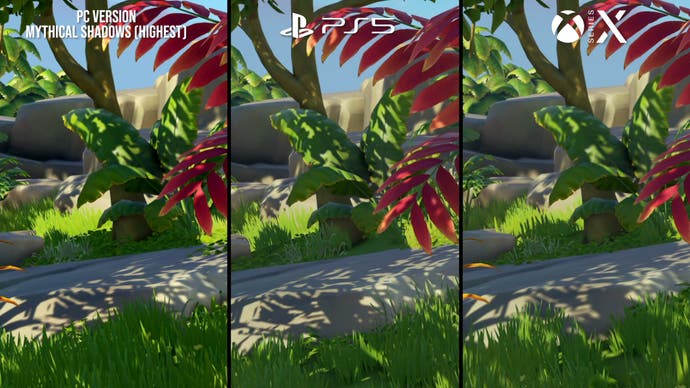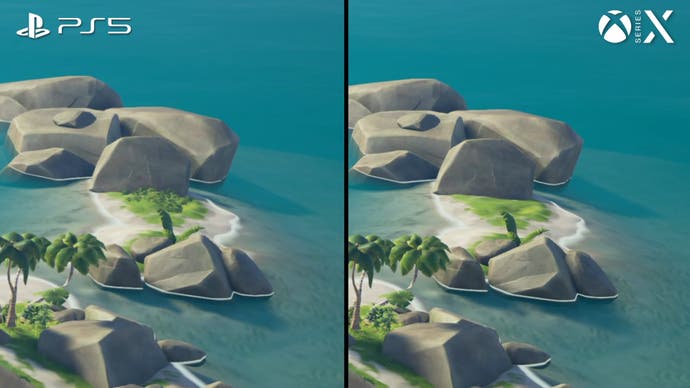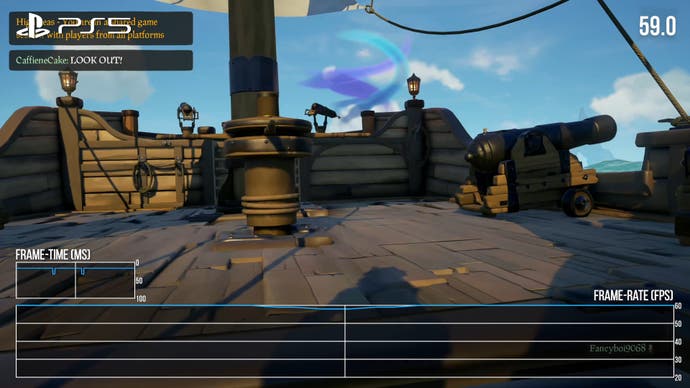Sea of Thieves on PlayStation 5: the next big Xbox multi-platform game tested
Plus: revisiting Xbox Series consoles and last-gen Xbox One X.
Sea of Thieves stared off life as an Xbox exclusive, growing over time into a genuine hit with a large, committed community. Now, in an effort to increase its audience still futher, it's become a key part of Microsoft's multi-platform push. Yes, Rare's pirate co-op title is headed to PlayStation 5, kicking off with an open beta last weekend. So just how good is the port and to what extent does the experience vary between PlayStation 5 and Xbox Series hardware? This has been an interesting project for Digital Foundry, not just because of the new version - but also because we missed out on covering the game in its transition to current-gen hardware, so we also took a look at the game to see how it has evolved up against Xbox One X.
The most interesting place to start is with a look at the brand-new PS5 version. To reiterate, we looked at beta code, and there may be changes when the game launches on April 30th, but it does seem quite polished at the moment. First impressions suggest a game that is very similar to its Series X counterpart - but when we look a bit closer, there are some differences. Shadows look quite a bit different on PS5, with a sharper outline and more visible detail. This holds true both up-close and at a distance, with far away shadows resolving more softly on the Series machine. This is definitely an odd change, and falls in line with a similar tweak found in the PS5 version of Hi-Fi Rush.
If we boot up the PC version at max settings, the PS5 version more closely resembles the highest shadow quality option, though neither console is a perfect fit. The PS5 and PC exhibit similar looking shadow detail, with slightly stronger filtering on PC, but if we step down to the legendary setting, both consoles clearly offer better and cleaner shadow rendering. I can't quite tell if this just comes down to a difference in shadow filtering or if the PS5's shadow resolution has been upgraded relative to Series X, but it is very curious for sure. I tended to prefer the PS5's shadow rendering for what it's worth, though it's not a difference I'd fixate on outside of head-to-heads.
There are also some changes to foliage. Most differences in head-to-heads are derived from procedural placement, which actually change on the same console from one run to the next, but that's not to say there aren't some more substantial differences elsewhere. I noticed the PS5 had a consistent edge when it came to draw distances for distant foliage elements, which sometimes appeared on the PlayStation when absent from Series X. Once again, these were very minor differences that you'd need a side-by-side to spot, but there is a clear PlayStation advantage here for some reason, which I don't really understand at the moment. On PC, the PS5 corresponds with max settings, with Xbox falling somewhat behind.
In terms of image quality, both platforms are delivering a 4K image. Dynamic resolution is a possibility, but neither console came in below 2160p in my testing. That doesn't quite translate into the smooth image you'd expect though, because Sea of Thieves doesn't appear to feature TAA at all. It's actually not clear if PS5 and Series X are getting any anti-aliasing treatment at all, because edges generally look pretty much untreated throughout the game. Sea of Thieves is still presenting a crisp and detailed image, just one that has less temporal stability than you'd expect, especially for an Unreal Engine 4 game. Series S gets the expected cutbacks: on the resolution front, we're rendering at just 1080p, again without obvious anti-aliasing treatment. The game looks a lot more aliased and suffers from a lot of additional breakup, which doesn't flatter the artwork.
Aside from that concession, visual settings between Series X and Series S do look fairly similar. Again, there is a foliage difference between the two, though this seems to stem from run-to-run variance, without an obvious major divergence in foliage draw distance. The shadow maps though, which were already pretty low-res, get a further cut-back and look a bit chunkier on the S, compromising close-range detail. At a distance, shadows are drawn more judiciously than Series X, with shadows cast from trees and other bits of foliage absent from the S. It's a noticeable change.
Texture quality also takes a hit, with lower resolution artwork all across the environment, though this is only noticeable at close range. Series S comes in with a 36GB install, versus around 90GB on PS5 and Series X. That said, Sea of Thieves has an art style that minimises high frequency detail, so the cut-down assets look pretty similar at a reasonable distance, with their lower resolution only becoming more obvious up close.
Sea of Thieves is a cross-gen title, so it was interesting to go back to take a look at the game running on Xbox One X. 4K rendering is native to both systems though weirdly, in a couple of shots I did notice better distant shadows on the One X, though in other areas they looked the same. I also noticed a small difference in shadow sharpness, favouring the One X, though this was smaller than the Series X/PS5 divide. Indirect lighting did seem better on the Series console over One X. Again, ultimately they do look very similar. The key divide here is that the Series X targets 60fps while last-gen is stuck with a 30fps target.
In terms of performance, all current-gen machines aim for 60fps by default, with somewhat mixed results. The Series X does mostly hit 60, with some substantial caveats. The game suffers from some dropped frames every so often, little 33ms or 50ms frame-time spikes that disrupt the flow of gameplay. These pop up frequently and without any apparent warning or corresponding on-screen load, so perhaps this is related to network play, because they rarely popped up in solo play. Conversely, in four-player lobbies, they tended to be at their worst.


Series S is much the same, though those little frame-time blips did seem rarer in my experience. It's a pretty decent experience on Microsoft's junior current-gen console. One thing to note here though is that Sea of Thieves doesn't feature any motion blur at all, so it's a bit less smooth than a lot of other 60fps titles - and at 30fps on last-gen machines, it does feel a little choppy. Unreal Engine 4 has excellent motion blur, so it's unfortunate it didn't make the cut here, even as an option.
PlayStation 5 follows a similar pattern, though the frame-time blips presented more like Series S than X. It's typically a 60fps experience, just with those minor annoyances added in. That said, on a few occasions, the game completely locked up, requiring a game restart, and I also saw the game crash at one point. I think these may just be network teething issues associated with the open beta, so I'm not inclined to judge these too harshly, but they were very disruptive and annoying.
More generally, Sea of Thieves network performance wasn't great. All consoles took a long time to find matches, even for single-player outings, though there's a good chance that this is attributable to the influx of fresh players the game experienced over the beta weekend. Additionally, on my Series S, I couldn't connect to the game at all normally as I suffered from the "Lavenderbeard" server error, requiring me to sign out of all accounts but one before I could play.


There is one thing I haven't covered so far though, and it's the game's 120fps mode. This is active on Series X consoles and PS5, and enables you to target 120fps while taking a resolution drop to 1080p. There are a couple other compromises too: shadows are lower quality and draw less often at a distance. Performance isn't that great though, to be honest. It is 120fps mostly, but it suffers frequently from really nasty frame-rate drops and stutters, sort of like the 60fps mode, but more obviously here. It's not a satisfying experience at all.
Unfortunately, this mode slipped my mind until just after the open beta ended, so I wasn't able to test it on my PS5 console. It is planned for the PS5 release though, and I would be surprised if performance was wildly out-of-step with the Series X. I'd rather play with the 60fps mode though, as dropping to 1080p severely degrades image quality and performance isn't great on Series X, but the option is there for players willing to make those compromises.
Sea of Thieves was a very good-looking game when it launched back in 2018, and I think that mostly holds true today. Perhaps its most impressive visual element is its water. The game features roiling, finely-tessellated waves, which look beautiful. Ocean waves peak with foamy froth and light penetrates through the tips of each wave. It's not just a nice effect either - the motion of the waves rocks the player ship back and forth, and is synchronised across players as well.


Reflections are handled in an interesting but effective way. The game doesn't appear to use screen-space reflections at all, which are an Unreal Engine staple. Instead, Sea of Thieves seems to make limited use of low-detail planar reflections, primarily to represent player ships and the outlines of islands. Depending on how intense the ocean waves are, these can look very convincing or not at all, with more violent seas exposing their 2D nature. Smaller pools of water make use of cubemaps, which suffer from some alignment issues depending on the angle but usually look decent enough.
The lack of SSR gives the ocean a lower-detail, more cartoony quality we find in games like the recent Skull and Bones. On the flipside though, there's a lot more temporal stability by not relying on a screen-space effect. The best solution, of course, would involve hardware ray tracing, which could look lovely here, though this would be an unlikely addition given the age of the game.
The high seas are where this game looks best, but the on-land segments look good too. Sea of Thieves' 74 islands are carefully hand-crafted and look great, with a chunky but rounded low-detail look. The silhouette of each island invites exploration and looks visually interesting, with carefully designed towns and fortresses scattered about as well. The on-land lighting looks decent too. Screen-space ambient occlusion is laid on thick here, but it generally produces a pleasing result given the cartoony art style.
The game also seems to have some form of global illumination in tow, which helps to flesh out some of the secondary lighting characteristics of each environment. It's far from the high-quality RTGI or baked lighting that we find in some more modern titles, and it does exhibit some pop-in, but the lighting generally looks good considering the game's scope.
I think Sea of Thieves is still a very good looking game and it doesn't really need any big upgrades to retain its visual charms on modern hardware. Some extra touches would have been appreciated of course - and the lack of TAA does mar the image somewhat - but I don't really have any major complaints.
The game's current-gen outings are far from perfect though: Sea of Thieves suffers from odd performance issues on Xbox Series and PS5 machines, which can dampen the experience, while the networking issues from the open beta should be sorted out before the game's April 30th PS5 release, because they were quite intrusive in my testing. Overall though, Sea of Thieves retains its signature charm - and should go down well with PlayStation players.










